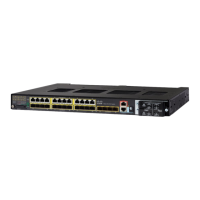649
Configuring QoS
Configuration Examples for Policy Maps
The number of defined classes in each output policy map must be same.
You must assign an action to each class; that is, there can be no empty class.
Each class configuration must be based on the classification/marking done in the input policy-map.
Modifying Output Policies and Adding or Deleting Classification Criteria
This section provides examples of updating an existing set of output policy maps to add or delete classification criteria.
The modification might be required due to a change in the service provisioning requirements or a change in the input
service policy map. You can make the change without shutting down any port.
In the initial configuration, Gigabit Ethernet ports 1 and 2 are NNIs and are enabled by default.
This is the overall sequence of initial configuration:
Change the configured class map for an input service policy.
Change the configured class map for an output service policy.
This example modifies classes for an input service policy by adding classification criteria to the silver-in class to also
match dscp cs5. This is required for the output policy-map to match to dscp cs5.
Switch(config)# class-map match-any silver-in
Switch(config-cmap)# match ip dscp af21
Switch(config-cmap)# match ip dscp cs5
Switch(config-cmap)# exit
This example modifies classes for an output service policy, adding classification criteria to the silver-out class to also
match dscp cs5. This adds dscp cs5 to the silver-out class on all configured and attached output service policies. The
dscp cs5 flow now receives the same queuing and scheduling treatment as the silver-out class.
Switch# config terminal
Switch(config)# class-map match-any silver-out
Switch(config-cmap)# match ip dscp af21
Switch(config-cmap)# match ip dscp cs5
Switch(config-cmap)# exit
You should use the same procedure when deleting a match statement associated with a configured class.
Modifying Output Policies and Changing Queuing or Scheduling Parameters
This section provides examples of updating an existing set of output policy maps to modify the parameters of the
configured queuing and scheduling actions. The modification in the output policy map might be required due to a change
in the service provisioning requirements. You can make the change without shutting down any port.
In the initial configuration, Gigabit Ethernet ports 1 and 2 are NNIs and are enabled by default.
The requirement is to change the action parameters.
Note these restrictions when configuring output policies:
You can define up to three classes in the output policy map.
The defined classes must be the same as other output policy maps.
The number of defined classes in each output policy map must be same.
You must assign an action to each class; that is, there can be no empty class.

